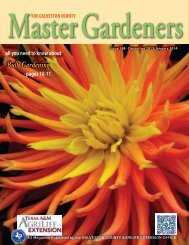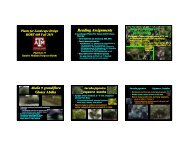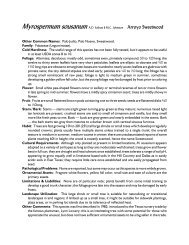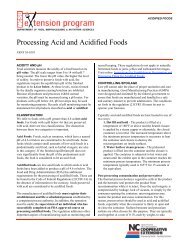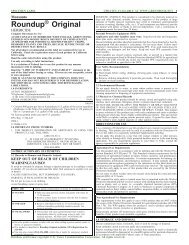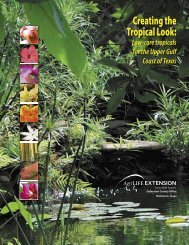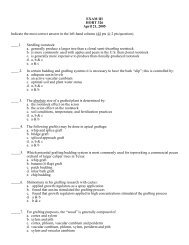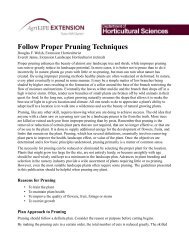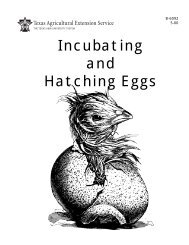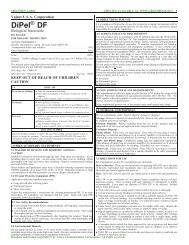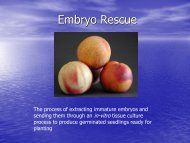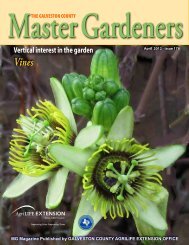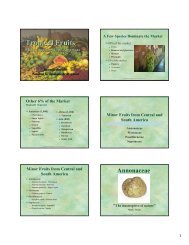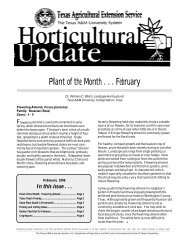AMF Enhancement of Plant Water Relations - Aggie Horticulture ...
AMF Enhancement of Plant Water Relations - Aggie Horticulture ...
AMF Enhancement of Plant Water Relations - Aggie Horticulture ...
You also want an ePaper? Increase the reach of your titles
YUMPU automatically turns print PDFs into web optimized ePapers that Google loves.
Texas Lignite Coal IndustryDrag LineCoal SeamNon-AM+AMDisturbed Site
Vesicular Arbuscular Mycorrhiza
Arbuscular Mycorrhizal <strong>Enhancement</strong> <strong>of</strong> <strong>Plant</strong> <strong>Water</strong> <strong>Relations</strong><strong>AMF</strong> enhancement <strong>of</strong> drought resistance may be response to better host nutrition—particularlyPhosphorus (Safir & Nelson, 1985); Nitrogen (Subramanian, 2003)Phosphorus <strong>AMF</strong> affect mechanisms that control plant water relations such as: aLeaf gas exchange (Hardie 1985; Davies et al. 1993; Koide 1993)Generally higher stomatal conductance and transpiration (Augé 2001)Turgor maintenance- osmotic adjustment (Augé et al 1986)Phytohormone production (Duan et al 1995, Nikolaou et al. 2003, Estrada-Luna &Davies, 2003)Nonhydraulic root to shoot communication <strong>of</strong> soil drying (Augé & Dunn 1991)Root hydraulic conductivity (Sweatt & Davies 1984; Nelson 1987; Cui & Nobel 1992;Syvertsen & Graham 1990)
<strong>AMF</strong> <strong>Enhancement</strong> <strong>of</strong> <strong>Plant</strong> <strong>Water</strong> <strong>Relations</strong> (con.)•Extraradical hyphae development-improved root/soil contact (30 to 100 m /g soil)(Benthlenfalvay et al, 1988, Davies et al, 1992)•<strong>Enhancement</strong> <strong>of</strong> soil structure, aggregate stability and subsequent t available soil water(Augé et al. 2001)•Greater carbon allocation (sink-regulated) to roots (Wright et al. 1998)Morphological ChangesHigher root-shoot ratio, greater lateral root formation, leaf abscission (Henderson &Davies, 1990);Leaf expansion (Koide, 1985) Better drought-acclimated <strong>AMF</strong> plants (greater plant fitness).Drought can enhance colonization & extraradical hyphae formation <strong>of</strong> <strong>AMF</strong>.
<strong>Plant</strong> <strong>Water</strong> <strong>Relations</strong>• <strong>Plant</strong> Acclimation to Drought•Acclimatization <strong>of</strong> TC produced plantlets
Drought Resistance [Levitt, 1980;Augé 2001](low external H 2 O potential)Drought Tolerance(Survival at low internal H 2 O potential)Drought Avoidance(Maintain high internal H 2 O pot.)Dehydration ToleranceDehydration Avoidance(Survival at low internal H 2 O content) (Maintain high internal H 2 O content)
APPROACH :Compare <strong>AMF</strong> and Non-<strong>AMF</strong> plants <strong>of</strong> comparable sizeand tissue nutritional status.Acclimate plants to drought via repetitive droughtcycles(bell pepper, Rosa hybrida), or a slowlydeveloping drought cycle (chile ancho peppers,neem tree seedlings).
Capsicum annuum(Bell peppers)Glomus deserticola
Bell Pepper: : Capsicum annuum L. ‘Early Bountiful’<strong>AMF</strong>:Glomus deserticolaFertilization: LANS 22 µg g P ml - 1 <strong>AMF</strong>; Non<strong>AMF</strong> 44 µg g P ml-1Drought Acclimated (DA) –PredawnΨ leaf-0.9 MPa; Ψ soil -0.5 MPaNondrought Acclimated (Non-DA)–PredawnΨleaf-0.2 MPa;1/2 plants subjected to four DA cyclesDA and Nondrought acclimated plants subjected to droughtDA and NDA given a 3-day 3recovery cycle.
Leaf water potential (Ψ(leaf ) <strong>of</strong> bell pepperduring peak drought & recovery
Leaf osmotic potential (Ψ(π ) <strong>of</strong> bell pepperduring peak drought & recovery
Net photosynthesis (A) <strong>of</strong> bell pepperduring peak drought & recovery
<strong>AMF</strong> <strong>Enhancement</strong> <strong>of</strong> Drought Stress-Bell Pepper<strong>AMF</strong> Peppers have: Leaf Chlorophyll Stomatal Conductance Photosynthesis Osmotic Adjustment Faster Drought Recovery Phosphorus & plant size notthe limiting factor
<strong>AMF</strong> Pepper <strong>Plant</strong>s have:•Greater Extraradical Hyphae formation•Greater Soil Aggregation•Improved Soil Tilth•Glomalin – hydrophobicprotein
→ Not all mycorrhiza respond equally to droughtChile ancho pepper:•Glomus fasciculatum(Trappe, Oregon)•ZAC-19: mixed Glomus species: G. albidium, G. claroides,G. diaphamum(Zacatecas, Mexico; 450 mm annual Precipitation;Chamizo, Ferrera-Cerrato, 1998)
Chile Ancho pepper plants during peak drought stress (day 20).<strong>AMF</strong> Drought SoilMoist.(%)ψ leaf(-Mpa)g s(mmol m -2s -1 )RWC(%)Whole <strong>Plant</strong>Transpiration(mg H 2Om -2 s -1 )WUE(10 -3 . g.kg -1 )Control No 17.0±1.4 0.1±0 268±14 92.6±1.4 48.2±1.4 5.34 18.9G. fasc. 18.3±0.4 0.1±0 257±13 88.9±1.1 48.1±1.4 5.29 18.7ZAC-19 18.8±0.2 0.1±0 233±19 93.0±1.9 46.7±2.1 5.09 18.8∆(‰)Control Yes 3.9±0.1 0.7±0.1 57±7 80.2±3.4 30.1±1.7 5.55 19.1G. fasc. 3.8±0.1 0.8±0.1 46±4 79.3±1.0 27.1±1.6 5.68 19.2ZAC-19. 4.1± 0.4 0.2±0 51±4 84.4±1.9 25.4±1.9 5.58 19.2Significance<strong>AMF</strong> NS 0.0001 NS NS NS NS NSDrought (D) 0.0001 0.0001 0.0001 0.0001 0.0001 NS NS<strong>AMF</strong> X (D) NS 0.0001 NS NS NS NS NS
Wilting <strong>of</strong> Chile Ancho pepper plants -- peak drought stress (day 20).<strong>AMF</strong> Drought % <strong>Plant</strong>snot wilted% <strong>Plant</strong>smoderatelywilted% <strong>Plant</strong>sseverelywiltedControl Yes 0±0 47±12. 53±12G. fasc. 0±0 26±10 74±10ZAC-19. 0±0 79±10 21±11Significance<strong>AMF</strong> NS 0.0026 0.0089Drought (D) 0.0001 0.0001 0.0001<strong>AMF</strong> x D NS 0.0026 0.0089
Effect <strong>of</strong> Drought Stress on Colonization <strong>of</strong> Chile Ancho pepperControlGlomusfasciculatumZac-19% ArbusculeFormation% VesicleFormationDroughtNo 0 56.4a 37.5bYes 0 21.6b 43.0a(Pr>F)NS 0.0001 NSDroughtNo 0 81.4a 29.9Yes 0 42.8b 26.1(Pr>F)NS 0.0001 NS% Total RootColonizationDroughtNo 0 90.2a 51.9bYes 0 62.7b 59.9a(Pr>F)NS 0.0001 0.003
VesiclesGlomus intraradiciesNeem (Azadirachta indica)Appressorium
Table 2. Growth parameters <strong>of</strong> mycorrhizal (<strong>AMF</strong>) and Non-VAMneem plants at the end <strong>of</strong> the drought stress cycle(23 days <strong>of</strong> drought followed by a 1 day recovery).<strong>AMF</strong>DroughtacclimationLeafNo.Leafarea<strong>Plant</strong> dry mass (g)Root/shootratio(m 2 )Leaf(g)Stem(g)Root(g)(g.g - 1 )Non<strong>AMF</strong><strong>AMF</strong>NoYesNoYes29±221±229±223±20.20±0.010.010.14±0.010.010.20±0.010.010.14±0.010.0118±111±118±112±111±18±111±09±111±19±012±19±00.38±0.030.030.47±0.030.030.40±0.020.020.43±0.030.03Significance<strong>AMF</strong>Drought<strong>AMF</strong> x DNS**NSNS**NSNS**NSNS**NSNS**NSNS**NS
<strong>AMF</strong> Effects on Neem Tree Seedlings ± <strong>AMF</strong> neem trees <strong>of</strong> similar size and nutrition respond to droughtsimilarly.Neem drought response: decrease in leaf area, gas exchange rate and waterrelations parameters.Rapid recovery after rehydration with an acclimation <strong>of</strong> stomatal conductance.
<strong>Water</strong> Use Efficiency Dry Mass gain per total water usage –(g Carbon/kg H 2 O) [Long Term] Gas Exchange: net Photosynthesis/ stomatalconductance (A)) / (g(s ) [Instantaneous]
Table 1. Wager Use Efficiency (WUE) in leaves <strong>of</strong> well-watered watered and droughtstressed <strong>AMF</strong> and Non-<strong>AMF</strong> neem plants during 23 days <strong>of</strong> drought followedby a 1 day recovery (day 24).Mycorrhiza(<strong>AMF</strong>)Droughtstress<strong>Water</strong> Use Efficiency(g DM/ kg H 2O)NoninoculatedInoculatedSignificance<strong>AMF</strong>DroughtInteractionNoYesNoYes2.50.92.41.2NS**NS
<strong>Water</strong> Use Efficiency (con)Stable Isotope Discrimination (C(C 13 /C 12 ) WUE not greater in <strong>AMF</strong> plants
Table 1. Carbon isotope discrimination (∆)() in leaves <strong>of</strong> well-watered watered anddrought stressed <strong>AMF</strong> and Non-<strong>AMF</strong> neem plants during 23 days <strong>of</strong>drought followed by a 1 day recovery (day 24).MycorrhizaDroughtstress∆ (‰)(<strong>AMF</strong>) Day 0 Day 24NoninoculatedInoculatedNoYesNoYesMature leaves20.71±0.170.1720.54±0.420.4220.32±0.260.2620.30±0.370.37Expanding leaves21.67±0.2618.66±0.2321.47±0.1219.03±0.590.59Mature leaves20.81±0.240.2420.35±0.510.5121.22±0.2820.18±0.350.35Significance<strong>AMF</strong>DroughtInteractionNSNSNSNS**NSNSNSNS
<strong>AMF</strong> --MICROPROPAGATED CHILE ANCHO PEPPER PLANTLETSDURING ACCLIMATIZATION AND POST-ACCLIMATIZATIONInoculation TechniqueSpore Slurry Solution:<strong>AMF</strong> Banding
Transplantation <strong>of</strong> Chile AnchoExplantGrowth Chamber 5 daysDay 1 — Near 100 % RHDay 2 — Near 100 %Day 3 — 80 %Day 4 — 70 %Day 5 — 60 %Day 6: Transfer to GHRooted Explant5-Day Growth ChamberTransplant
Development <strong>of</strong> mycorrhiza in micropropagated chile ancho pepper(Capsicum annuum L. cv. San Luis) plantlets during acclimatizationand post-acclimatization(Estrada-Luna & Davies, 2003).
Relative watercontent [RWC]Transpiration [E][Stomatal conductanceNoncolonized (Non<strong>AMF</strong>)and <strong>AMF</strong> micropropagatedchile ancho pepper(Capsicum annuum L. cv.San Luis) plantlets duringacclimatization and post-acclimatization(Estrada-Luna & Davies, 2003).Photosynthesis [A][
Leaf chlorophyll <strong>of</strong> noncolonized (Non<strong>AMF</strong>) and <strong>AMF</strong> micropropagatedchile ancho pepper (Capsicum(annuum L. cv. San Luis) plantlets duringacclimatization and post-acclimatization.(Estrada-Luna & Davies, 2003).
Leaf ABAStem ABAAbscisic acid (ABA) innoncolonized (Non<strong>AMF</strong>)and <strong>AMF</strong> micropropagatedchile ancho pepper(Capsicum annuum L. cv.San Luis) plantlets duringacclimatization(Estrada-Luna & Davies, 2003).Root ABA
Summary <strong>AMF</strong> can enhance plant water relations independent <strong>of</strong> tissue P. Differences among <strong>AMF</strong> isolates in plant water relations. <strong>AMF</strong> not more <strong>Water</strong> Use Efficient Decreased ABA. Drought stress can enhance <strong>AMF</strong> symbiosis. <strong>AMF</strong> plants are better acclimated to drought (greater plant fitness) Importance <strong>of</strong> Extraradical Hyphae-associated associated soil characteristics-soil moisture retention Mechanistic understanding <strong>of</strong> <strong>AMF</strong> & <strong>Water</strong> relations is incomplete(Safir et. al, 1972; Reid, 1979; Augé 2001, 2003)
L. Aguilera-GomezM.J. AlvaradoA. AlarconM. A. ArnoldS.H. BoT.W. BouttonC. CalderónC.A. CallL. Amaya de CarpioA. CartmillCollaboratorsM.C. DrewS.A. DurayJ.N. EgillaA. Estrada-LunaR.C. Ferrera-CerratoY-C C HeJ.C. Henderson-ColeZ. HuamanR.G. LindermanJ.C. Miller, Jr.S.E. NewmanR.J. NewtonL. PhavuphutanonJ.R. PotterV. Olalde-PortugalJ.D. PuryearJ.A. Saraiva GrossiM.E. StrongS.E. SvensonM.E. Sweatt



